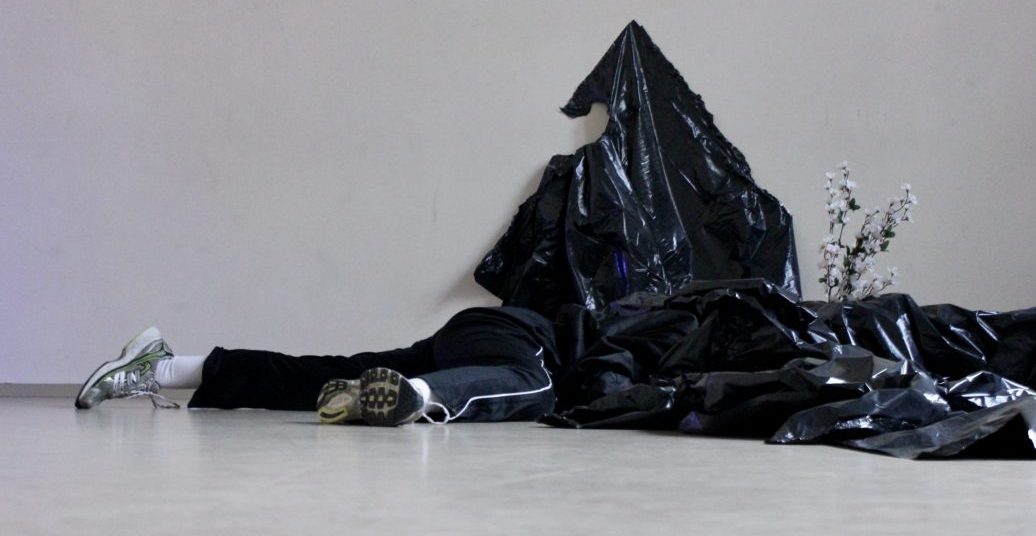“Hardcore Internet” documents the four-week research process by dance artist Julia Plawgo at ada Studio. Filmed and directed by Plawgo herself in the form of an open rehearsal, it was streamed online from 30 April till 2 May on ada Studio website. Dealing with themes such as digital space, video games, offline and online life, this work in progress made for the screen creates an alternative space where screened choreography and dance expand on different layers for “living bodilessly in a digital space”.
It is May 2021, and 16 months after the pandemic started, we are still working, maintaining our relationships, and experiencing our life mainly through screens. During this time, dance artists have had to rethink their practices to develop new survival strategies. This translation into the online format has shaped the way we look at dance today. In her research, Plawgo aims to create an act of resistance against this complex reality. In watching this work, there is a feeling that she is engaged in a discourse that reveals a unique personal perspective. With references to video game culture and to a generational experience of “living bodilessly in a digital space”, she creates an overlapping series of moving images integrated within an encompassing poetic stream.
The piece starts with a full-screen frame of a black plastic surface, lit by a strobe. A second smaller frame on the righthand side overlaps with a bundle of black cables across a white wall. A few moments later, in a third frame on the lefthand side, the dancer (Plawgo herself in casual black clothes and pale sneakers) performs a movement sequence on her knees in a dance studio flooded with natural light. From the very beginning, a rhythmic and, at the same time, evocative soundtrack is playing. Shortly after, a game where three frames are shown at the same time begins. A continuous mutation of the subject being framed — from the previously mentioned black cables, to plastic flowers on a black plastic sheet, to details of used sneakers, bricks, and strobe lights — regulates the film’s rhythm and the choreographic structure of the performer’s movements. Plawgo’s movement sequences are imbued with a primordial yet seductively restrained energy: from bouncing that recalls club culture, to torso shaking, and slow, and regulated gestures. In these last, I notice a search for animality that out of necessity creates a contrast with the plastic elements such as the flowers and the black sheet. Plawgo’s posture and physical presence, reinforced by repetitive movements, reiterate this imagery. And as in a video game, we encounter various levels of images.
Two specific moments catch my attention. The first is when Plawgo dances in the middle of the studio without any other juxtaposed filmic frames. She reaches towards a vertical position with an accumulation of repetitive open-then-closed arm gestures which transform her body into a black creature, somehow evoking both an eagle and some supernatural living thing made possibly of plastic. The second is when, almost at the end of the piece, on one side we see the performer upside down attached to the wall, and on the other, a black plastic sheet surrounded by plastic white and mauve flowers also stuck to the wall. The two bodies and two surfaces communicate with one another even though they are made up of very different materials.
The finale gives itself over to pop. A very famous song supports an almost cathartic ending where the performer, now in a white t-shirt, approaches the black plastic form, becoming part of it, creating an impression of tenderness. The irregular flash of the strobe reinforces a state of alertness, hyper-stimulating my nervous system somehow as in a video game. But it also has another effect: it creates a state of estrangement for the audience.
Plawgo works with editing as a powerful tool to select moments where diverse and ever-changing frames evoke the structure of a video game. I find myself totally engaged in this process as well as stimulated by the rhythmic electronic music. In “Hardcore Internet”, created both as a movement performance and as an artwork for the screen, Plawgo navigates and dominates a horizon familiar from experiences of life online. Through the use of screens, video camera, and selected frames, she creates various landscapes. The camera is fixed when the performer dances and only moves in order to show details of objects. This work encompasses dance and mixed media, creating a screen–dance work which designates camera, screen, and body as performative agents.




